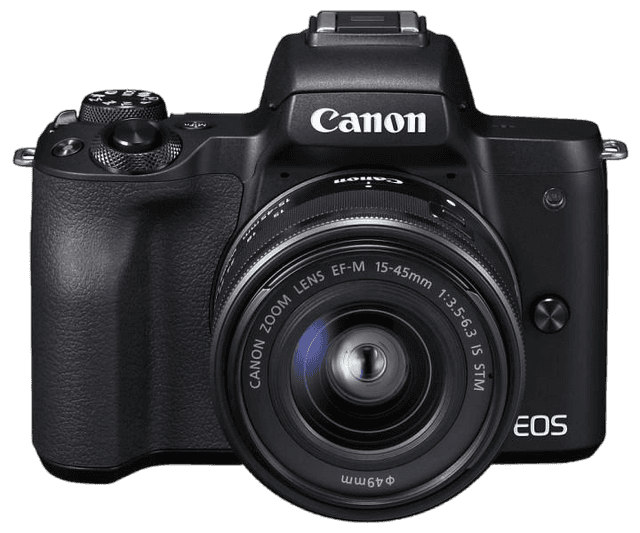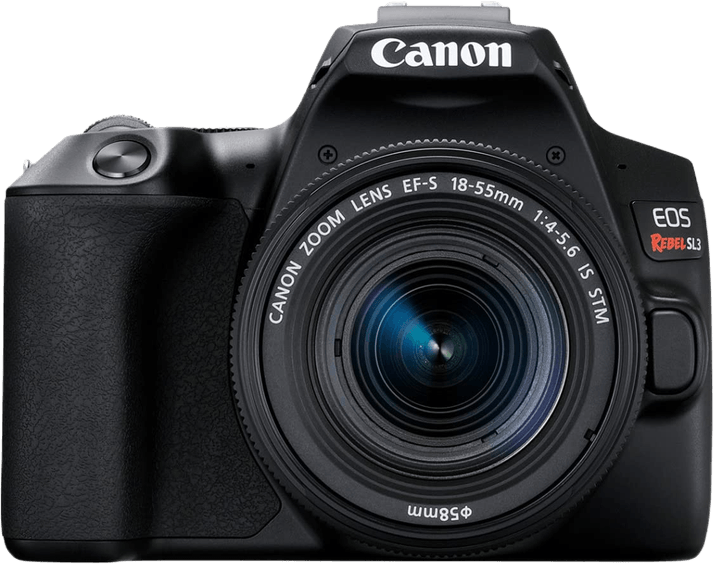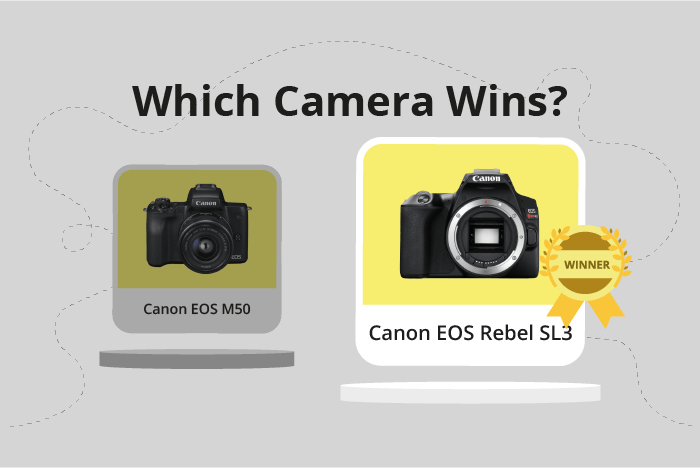Canon EOS M50 vs Rebel EOS SL3 / 250D Comparison
Canon EOS M50

Canon EOS Rebel SL3 / 250D

The Canon Rebel EOS SL3 / 250D outperforms the Canon EOS M50 with a score of 63/100 compared to the latter’s 59/100. Both cameras share similarities such as their announcement dates in 2018 and 2019, and their respective launch prices of $779 and $599.
The EOS SL3, being a DSLR, offers a more traditional shooting experience and has a better score due to its overall performance. On the other hand, the EOS M50 is a mirrorless camera, which makes it lighter at 390g compared to the 449g of the EOS SL3. This difference in weight may be a deciding factor for some users.
Despite the EOS M50’s lower score, it still has its merits with its compact size (116 x 88 x 59mm) compared to the slightly larger EOS SL3 (122 x 93 x 70mm). The choice between the two cameras ultimately depends on user preferences and priorities, such as weight, size, and shooting experience.
Canon EOS M50 vs Rebel EOS SL3 / 250D Overview and Optics
The Canon Rebel EOS SL3 / 250D wins in the optics comparison with a score of 61/100, while the Canon EOS M50 scores 59/100. Both cameras share common specifications, including 24 megapixels, CMOS sensor type, Digic 8 processor, and APS-C sensor size.
The SL3 / 250D excels with its DXOMARK sensor score of 64, compared to the M50’s score of 58. This means the SL3 / 250D has a better sensor performance, resulting in improved image quality. Additionally, the SL3 / 250D features image stabilization, which is absent in the M50. Image stabilization helps in capturing sharper images, especially in low-light conditions or when using longer focal lengths. The SL3 / 250D also has a versatile lens mount, allowing it to use both Canon EF and EF-S lenses, providing more lens options for photographers.
On the other hand, the EOS M50 has a faster shooting speed of 10 frames per second (fps), compared to the SL3 / 250D’s 5 fps. This makes the M50 better suited for capturing fast-moving subjects, such as sports or wildlife photography. However, the M50’s lens mount is limited to Canon EF-M lenses, which restricts the available lens choices.
Considering the optics, the Canon Rebel EOS SL3 / 250D is the superior camera due to its better sensor performance, image stabilization, and versatile lens mount. The Canon EOS M50 performs well in terms of shooting speed but falls short in other areas. Ultimately, photographers should weigh the importance of these factors when choosing between these two cameras.
Canon EOS M50 vs Rebel EOS SL3 / 250D Video Performance
The Canon EOS M50 emerges as the winner in video capabilities with a score of 91/100, outperforming the Canon Rebel EOS SL3 / 250D, which scores 83/100. Both cameras share some common specifications, such as 4K max video resolution, 3840 x 2160 max video dimensions, and built-in time-lapse functionality.
The EOS M50 stands out with its higher max video frame rate of 120fps, compared to the Rebel SL3 / 250D’s 60fps. This allows for smoother and more detailed slow-motion footage, making it a superior choice for videographers who require high-quality video capturing.
Despite its lower score, the Rebel EOS SL3 / 250D does have some advantages. Its lower frame rate of 60fps may be sufficient for casual users who do not require professional-grade slow-motion capabilities. Additionally, the Rebel SL3 / 250D is part of Canon’s DSLR lineup, which may appeal to users who prefer the traditional DSLR form factor over the mirrorless design of the EOS M50.
Taking these points into consideration, the Canon EOS M50 is the superior choice for users who prioritize video capabilities, especially for slow-motion footage, due to its higher max video frame rate. On the other hand, the Canon Rebel EOS SL3 / 250D may be more suitable for casual users who do not require advanced video features and prefer a DSLR design.
Canon EOS M50 vs Rebel EOS SL3 / 250D Features and Benefits
The Canon EOS M50 and the Canon Rebel EOS SL3/250D both have a feature score of 70/100. These cameras share several specifications, making them comparable in terms of features. They have the same 3-inch screen size, 1,040,000-dot screen resolution, touchscreen capability, flip screen, GPS absence, and WIFI and Bluetooth connectivity.
The Canon EOS M50 surpasses the Canon Rebel EOS SL3/250D in certain aspects. However, since both cameras have the same feature score, there are no specific advantages of the EOS M50 over the Rebel EOS SL3/250D.
On the other hand, the Canon Rebel EOS SL3/250D also does not have any distinct advantages over the EOS M50, as they share the same feature score and specifications. Both cameras perform equally well in terms of screen size, resolution, connectivity options, and other features.
In comparing the Canon EOS M50 and the Canon Rebel EOS SL3/250D, it is clear that both cameras offer similar features and performance. There is no significant difference between the two models, as they both have the same feature score of 70/100. Users can expect comparable experiences when using either camera, with their identical screen size, resolution, and connectivity options.
Canon EOS M50 vs Rebel EOS SL3 / 250D Storage and Battery
The Canon Rebel EOS SL3 / 250D outperforms the Canon EOS M50 in storage and battery, with a score of 45/100 compared to the M50’s 13/100. Both cameras share common specifications, including one memory card slot and compatibility with SD, SDHC, and SDXC (UHS-I) memory cards. Neither camera offers USB charging.
The SL3/250D’s significant advantage lies in its battery life, offering 1070 shots per charge using the LP-E17 battery. This is considerably longer than the M50’s 235 shots with its LP-E12 battery. The extended battery life makes the SL3 / 250D a more reliable choice for extended shooting sessions.
The M50 does not have any notable advantages in storage and battery over the SL3 / 250D. Its shorter battery life may be a drawback for users who require longer shooting times without changing batteries.
Given the considerable difference in battery life, the Canon Rebel EOS SL3 / 250D is the clear winner in storage and battery capabilities. This advantage makes it a more suitable choice for photographers who need a reliable camera for longer periods of use.
Alternatives to the Canon EOS M50 and Rebel EOS SL3 / 250D
Are you still undecided about which camera is right for you? Have a look at these popular comparisons that feature the Canon EOS M50 or the Canon Rebel EOS SL3 / 250D:

